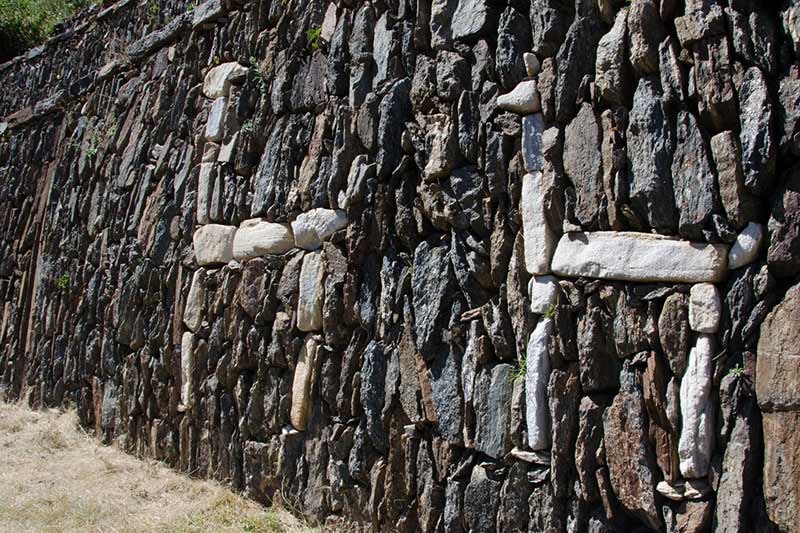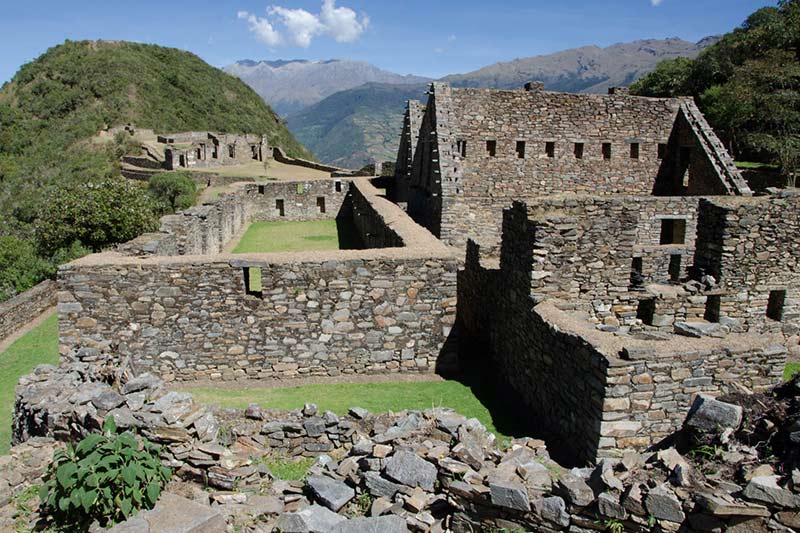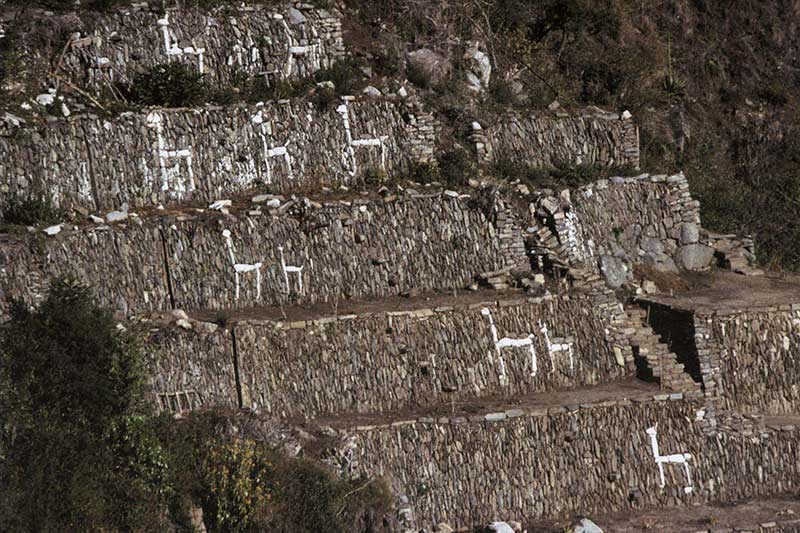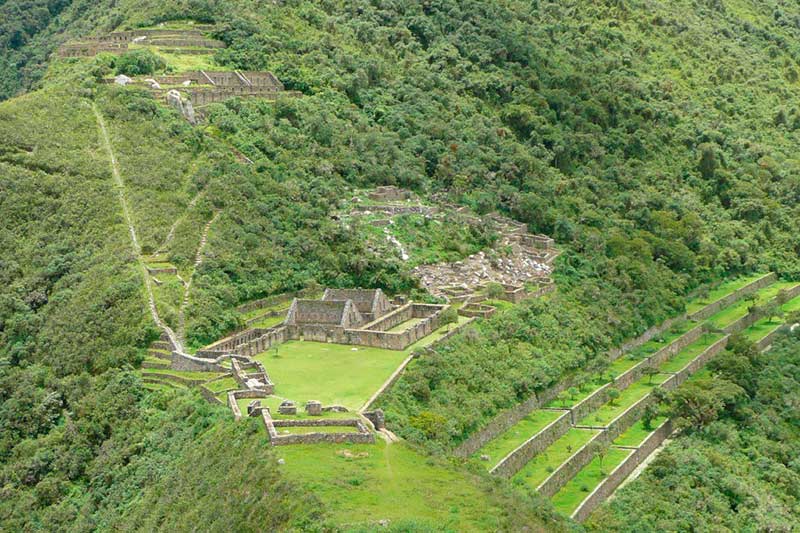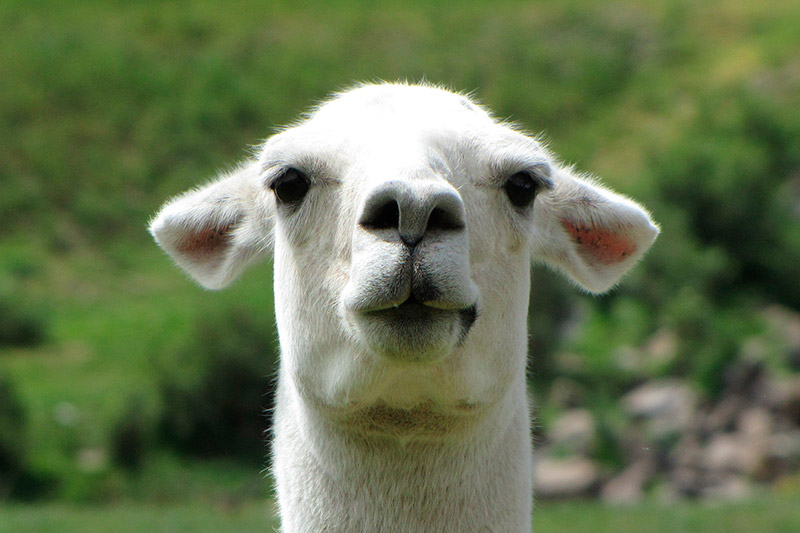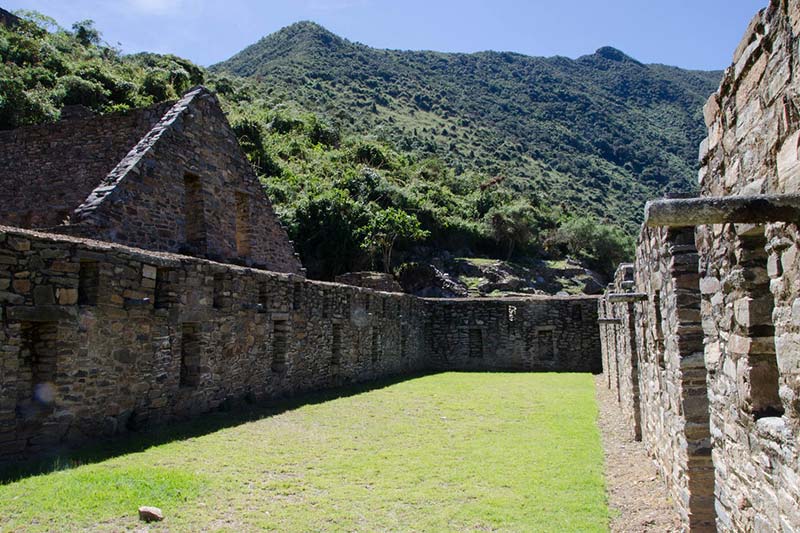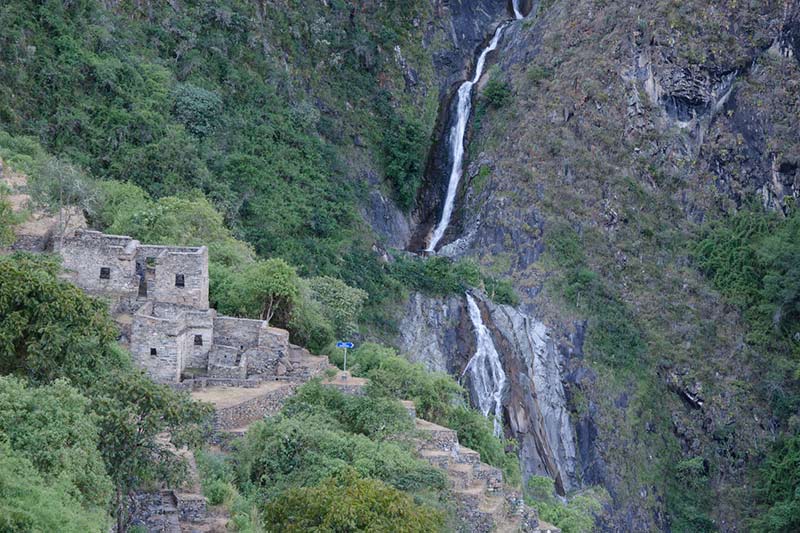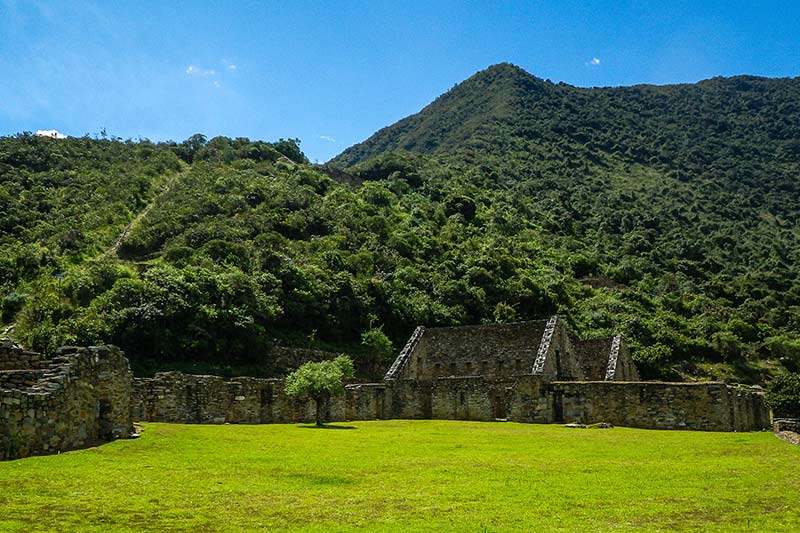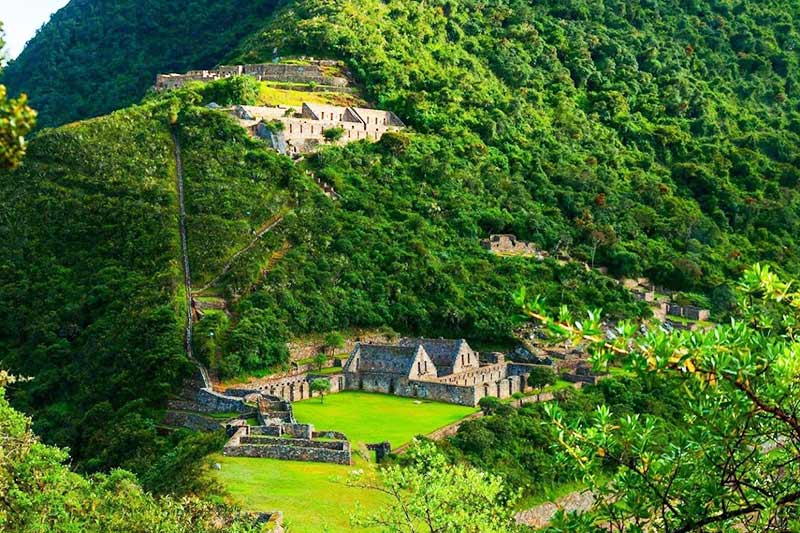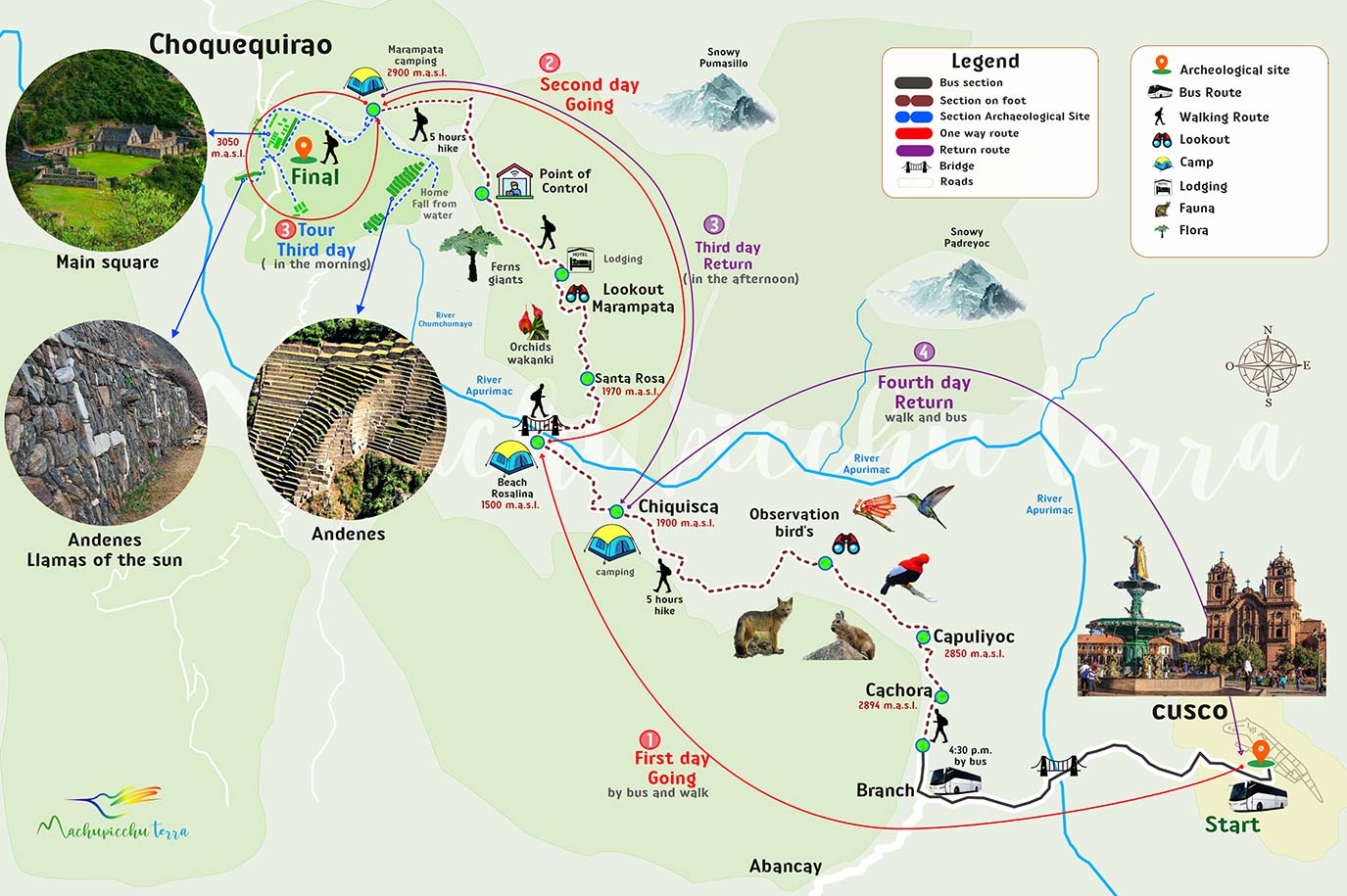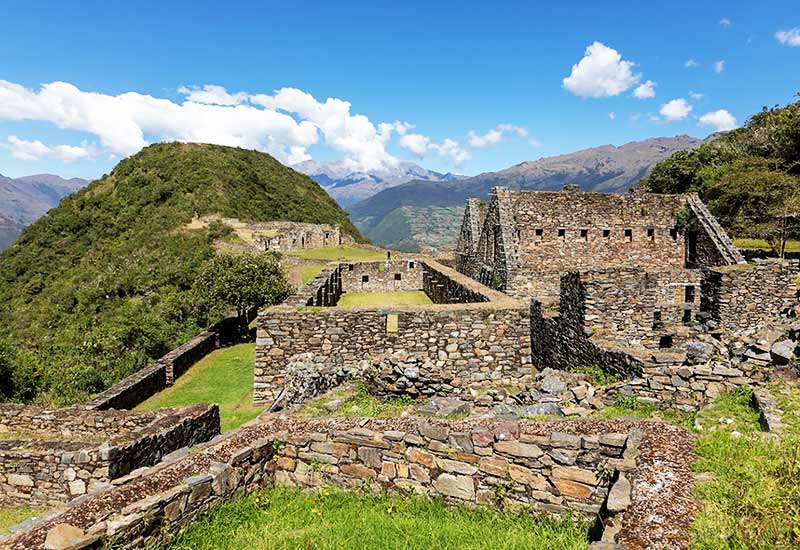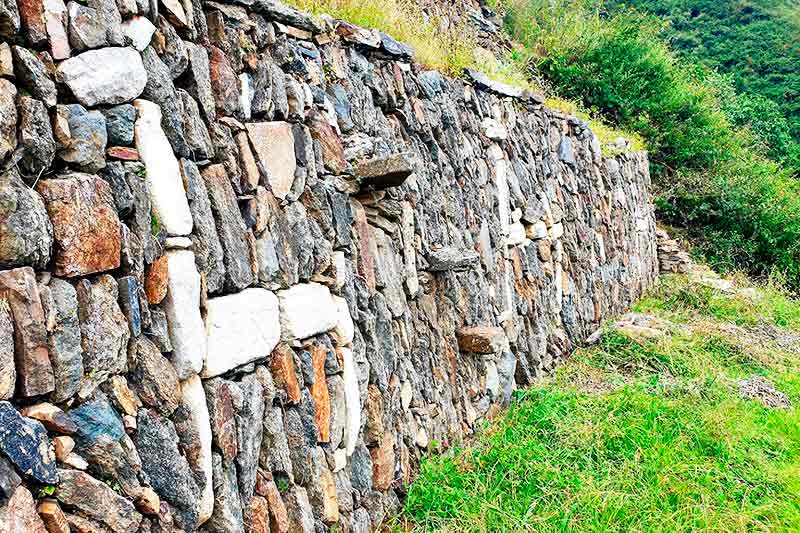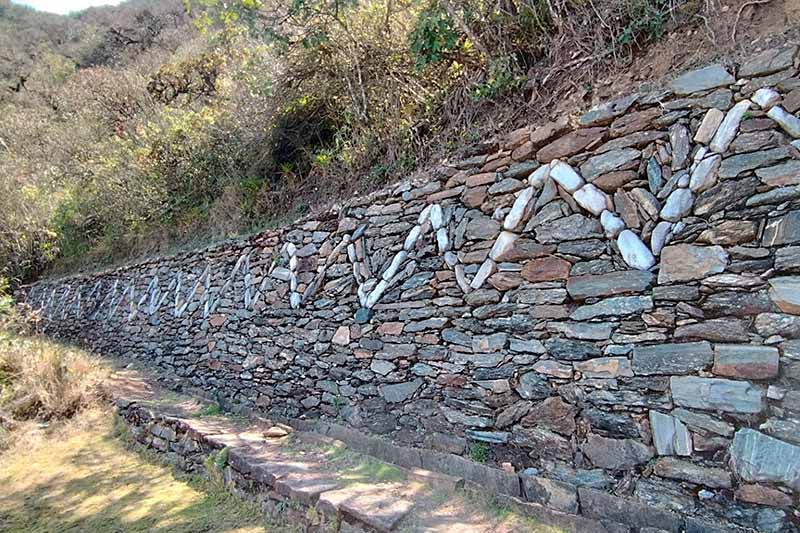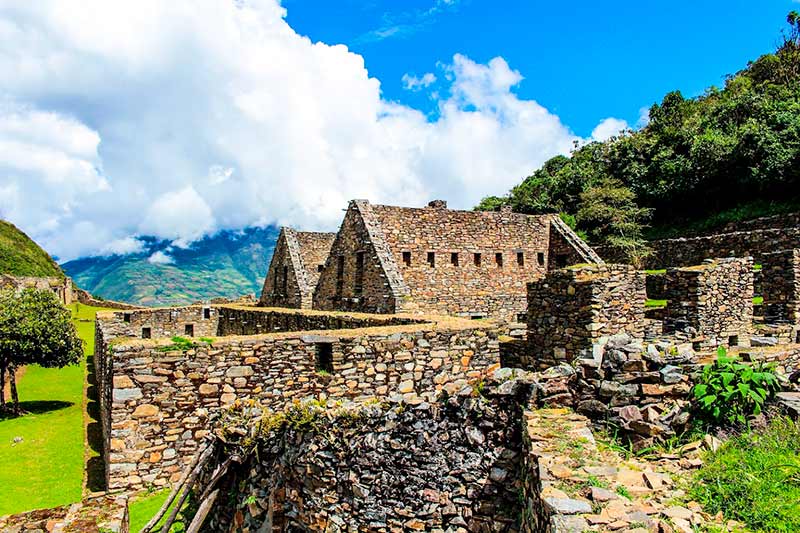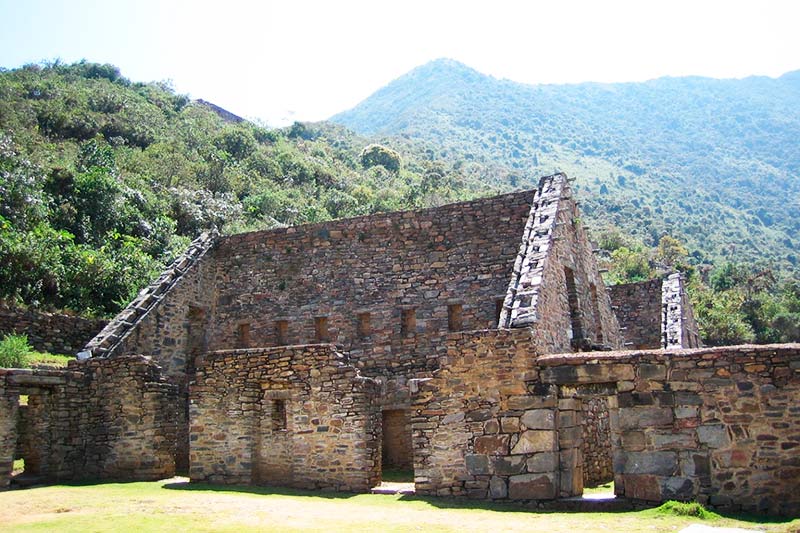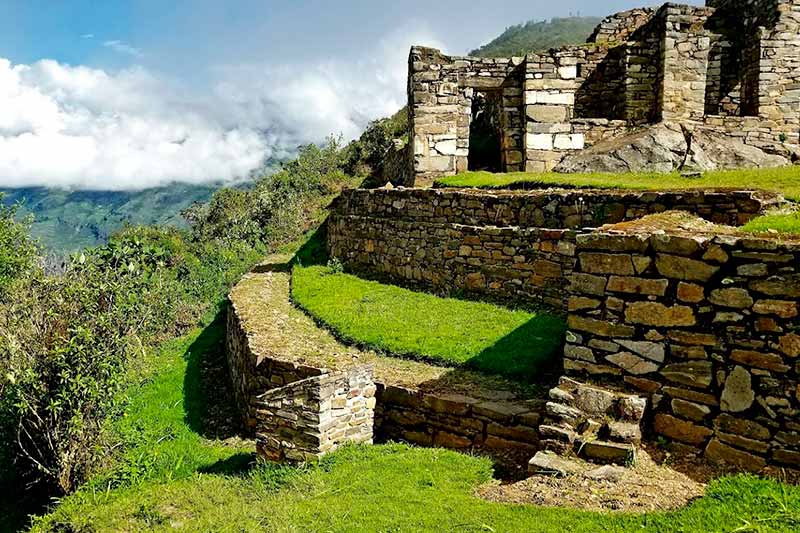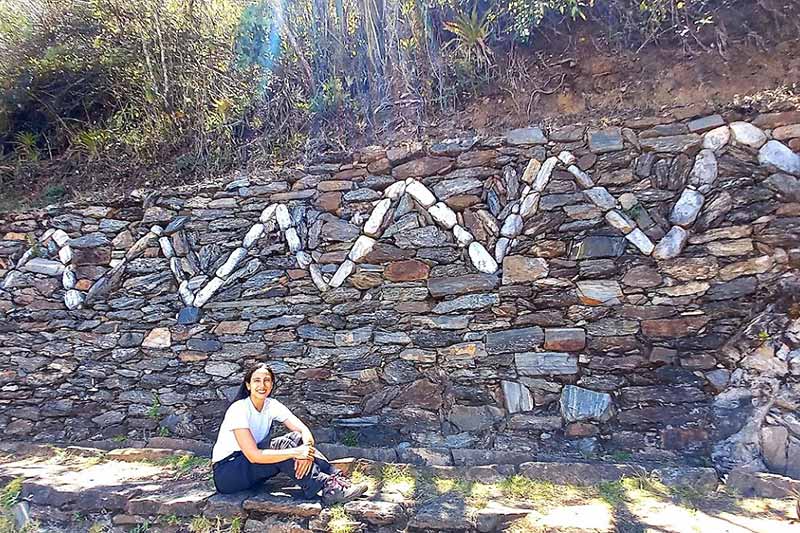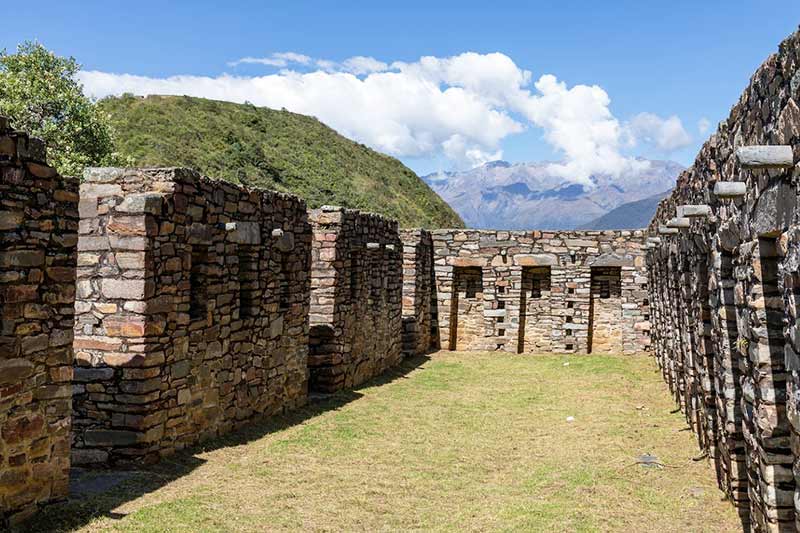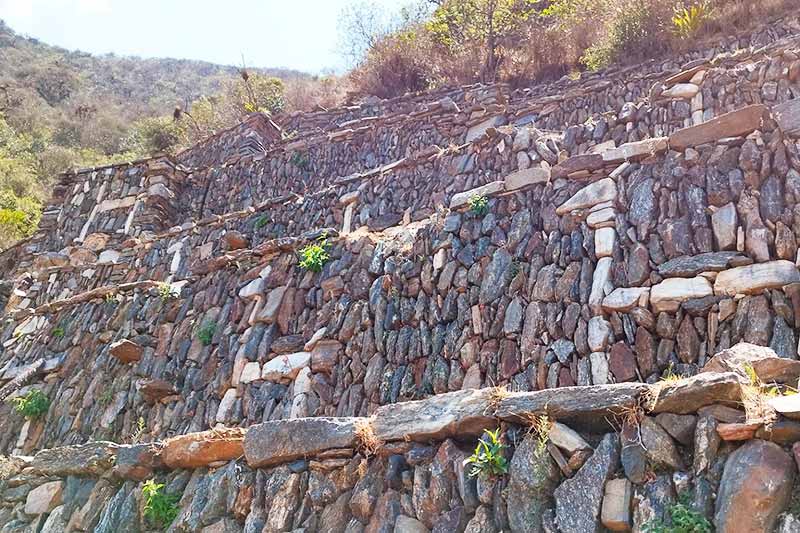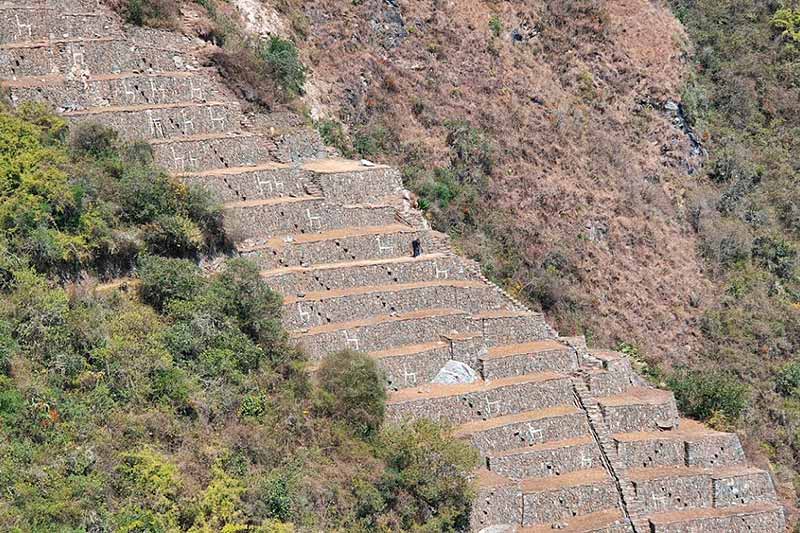The post The llamas of the sun in Choquequirao first appeared on Ticket Machu Picchu.
]]>- The importance of Choquequirao
- The llamas of the Sun of Choquequirao
- Where is Choquequirao?
- How to get to Choquequirao?
- What to wear?
- When is the best date to go?
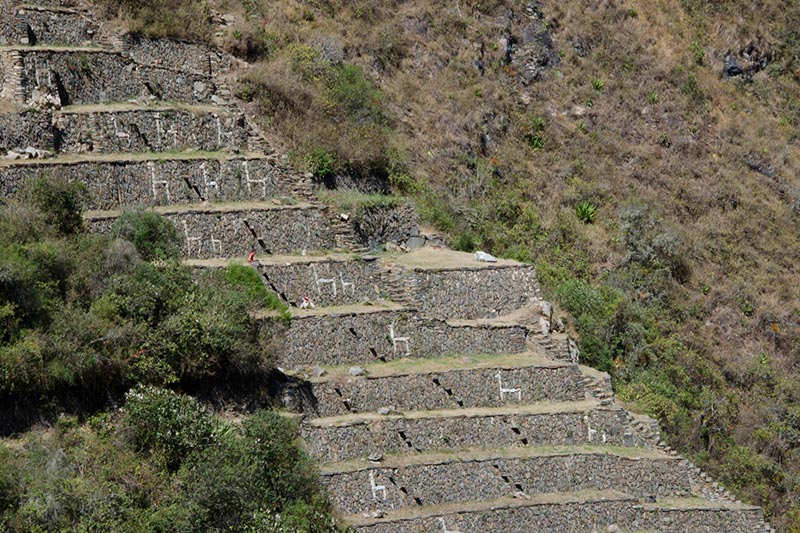
llamas of Choquequirao
It is possible to appreciate the sequence of figures of the 24 llamas of the sun with a panoramic view of this entire sector of terraces. In this way, all zoomorphic representations make more sense.
The importance of Choquequirao
Choquequirao was a Tawantinsuyo citadel of great importance because it was built strategic point to connect the Andes and the jungle. This detail, although it may seem insignificant, is not. Both in the past and today, dominating or controlling the vast vegetation is difficult. Locating a citadel at this point would encourage expansion campaigns in the future, but the Spanish invasion deteriorated all these expansionist missions.
Little by little, more of everything that this place hides is discovered. According to the academic records, just an adequate study of 30% of the entire place was achieved. Choquequirao is larger than Machu Picchu and presents another type of construction and a greater number of terraces. At present, some particular studies are being carried out on certain sectors. This is the case of Las llamas del Sol from Choquequirao, which was recently studied in more detail. A really interesting study is the one carried out by Zenobio Valencia and Gori-Tumi Echevarría, which we will see later.
Let’s know some details briefly about Choquequirao:
- It has an altitude of 3500 meters above sea level.
- It is located between the regions of Cusco and Apurímac.
- It is on a mountain, and the buildings rub against the clouds.
- Choquequirao connects with the Vilcabamba valley, and the Apurímac valley, you can also take a hiking route to Machu Picchu.
- It is very close to the District of Santa Teresa.
- It was probably ordered to be built by the Inca Túpac Yupanqui.
- It is estimated that a part of the construction of a culture before that of the Incas. The Incas, after their conquest, established their type of architecture.
- If you want more information about Choquequirao, we invite you to see The truth about Choquequirao.
The lamas of the Sun of Choquequirao
Choquequirao still does not have 100% scientific studies, the study in these areas is complicated, so one can speculate on the different possibilities and conditions under which it was built. Something similar happens with Machu Picchu, are considered sisters due to the similarity, they have when using ravines or high peaks as settlements.
The llamas de Choquequirao is considered a special and unique construction for different reasons, one of which is that you cannot find similar constructions or buildings that at least have a similarity. This special characteristic is also because all the Inca archaeological sites or before them, do not have this formation. For specialists, all Choquequirao has a unique feature in the world.
The lamas of Choquequirao would come to represent an act, they follow a sequence in which they approach the main square. Although this sounds less important, it is not, the sequence is arranged in such a way that exists a narrative in the order. In addition, the stones that make up the llamas have a white color that contrasts with the rest of the gray. Something important to highlight is that they are structural decorations, this means that if someone decides to remove or remove the stones that make up the llamas, it would cause the platform to collapse or at least cause considerable damage.
The entire sector of the Lamas of the Sun, makes us understand the planning of the construction since to understand the movement that has the sequentiality of the act, it is necessary to have a panoramic view of the entire sector. The 24 lamas have a juxtaposed arrangement that connects from platform to platform. This form of artistic expression is what exalts its particularity compared to the rest of pre-Columbian art.
Archaeological Investigations in Choquequirao, Cusco, Peru. Vol. 1 (2019) is the book that brings together some of the recent archaeological and scientific studies of the sister of Machu Picchu. In the book, you can find a review of stories, previous records, and reports of some excavations. If you are a lover of Peruvian history, you cannot miss this text by the authors: Gori – Tumi Echevarría and Zenobio Valencia.
Where is Choquequirao?
Choquequirao is located on a plateau that borders the valleys and canyons formed by the Urubamba River. It is located in the district of Santa Teresa – Choquequirao belongs to the province of La Convención in the Cusco region. It is rarely visited because access is only through hiking trails. This allows few visitors to the entire Choquequirao archaeological site.
How to get to Choquequirao?
The only way to get to Choquequirao is through hiking trails. The minimum number of days is four days, including a round trip. This hiking route begins in the community of Cachora. Cachora is approximately 4 hours away. The distance from Cachora to Choquequirao is 32 kilometers along different ascending and descending trails. During the walk, it is possible to appreciate beautiful landscapes.
What to wear?
In recent years, the completion of the cable car project is expected, which achieved a more fluid visit to the place. Until that happens, the only way to get to Choquequirao is by hiking, which takes approximately 4 days. For this trip, what is necessary is to have resistant footwear ideal for hiking, light clothing, and change for the 4 days, and finally, the desire to discover all this spectacular Inca construction.
When is the best date to go?
If you are an adventure lover and ready for challenges, any time or month of the year is ideal to visit Choquequirao. However, to avoid any unforeseen events or problems, it is recommended to make the trips in the dry season which includes the months of April to October. If you want to visit Choquequirao for the rest of the months, we recommend that you check the weather conditions for the days on which you join the adventure.
By Ticket Machu Picchu – Last updated, August 15, 2024
The post The llamas of the sun in Choquequirao first appeared on Ticket Machu Picchu.
]]>The post Trek Cusco – Choquequirao – Machu Picchu first appeared on Ticket Machu Picchu.
]]>- Choquequirao, the last Inca refuge
- Machu Picchu, Wonder of the World
- Machu Picchu and Choquequirao: similarities and differences
- The hiking trail Cusco – Choquequirao – Machu Picchu
- Other hiking routes to Choquequirao and Machu Picchu
- Recommendations to visit Choquequirao and Machu Picchu
- Questions and answers about visiting Choquequirao and Machu Picchu
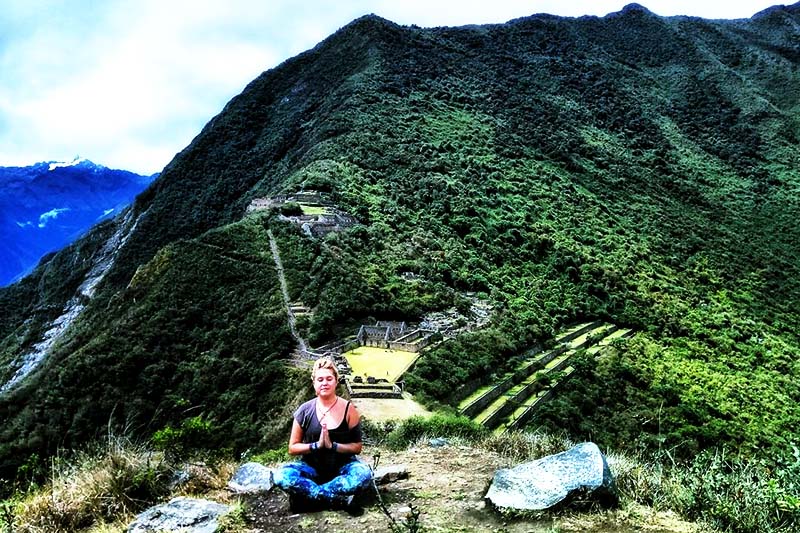
Trekking Cusco-Choquequirao-Machu Picchu, one of the most complete and challenging adventures
Why are Choquequirao and Machu Picchu so similar?
Choquequirao is called ‘The sacred sister of Machu Picchu’. There is a similarity between both archaeological sites. This is because they are located in similar geographies in high mountains from where there is surveillance of possible invaders. Both have large agricultural sectors and temples worshiping the sun. Both places were built in the 15th century, so their urban design is also similar.
Choquequirao, the last Inca refuge
- The ruins of Choquequirao are an ancient Inca city located between the mountains belonging to the snowy Salkantay in Cusco.
- In 1909, the American explorer Hiram Bingham visited this place of difficult access. However, it was not until the mid-1970s that the first excavations of this archaeological site began.
- Currently only 30% of the immense site was excavated. Despite this it is one of the most mysterious tourist attractions due to its similarity with Machu Picchu.
- It is known as the last Inca refuge due to the belief that the remnants of Manco Inca were hidden there after the Spanish conquest.
- It is also known as the ‘Sacred Sister of Machu Picchu’ due to the architectural similarity with the Inca Citadel.
- The only way to get there is through a 2-day hiking trail along rivers, high mountains and breathtaking landscapes.
Machu Picchu, Wonder of the World
- Machu Picchu is an Inca site located in the eastern part of the central Andes.
- It belongs to the foothills of Salkantay, in southern Peru.
- It is believed that this site was the urban, religious center and residence of the Inca Pachacutec, who commanded its construction in the early fifteenth century.
- With the Spanish conquest, the place was gradually abandoned until it was covered by the abundant vegetation characteristic of the area.
- In 1911, the American explorer Hiram Bingham made known to the world the importance of the archaeological complex.
- In 2007, the Inca llaqta was chosen as one of the Wonders of the modern World. Since then, tourist traffic has skyrocketed.
- Today, its mysterious stone constructions around beautiful mountainous landscapes are one of the most visited places on the planet.
- It is estimated that around 1 million people visit it a year.
Machu Picchu and Choquequirao: similarities and differences
|
Machu Picchu
|
Choquequirao
|
|
|---|---|---|
| Name | Old mountain | Golden cradle |
| Construction | In the time of Pachacutec (1438 – 1471 AD). |
In the time of Túpac Yupanqui (1471 – 1493 AD). |
| Location | In the district of Aguas Calientes, Urubamba province, department of Cusco. |
In the district of Santa Teresa, province of La Convencion, department of Cusco. |
| Altitude | 2,430 masl. | 3,033 masl. |
| Function | Citadel, religious site and strategic position for connection of Cusco with the Amazon of the Inca empire. |
Citadel, religious site and strategic position for connection of Cusco with the Amazon of the Inca empire. |
| Area | 5 square kilometers | 18 square kilometers |
| buildings | Platforms, terraces, temples, roads, houses and royal enclosures. |
The colonial plaza, colcas, platforms, homes, kallankas, ushnus and inca cemetery. |
| Visit | With 1 day tours, 2 days or 4 day hiking route, 5 days or more. |
Con tours de ruta de 4 day hiking, 5 days or more. |
| Entrance | 44 dollars for adult tourists | 18 dollars for adult tourists |
| Schedule | Every day from 6 am to 5 pm. | Every day from 7 am to 5 pm. |
| Climate | 8ºC. at 24ºC. | 12ºC. at 24ºC. |
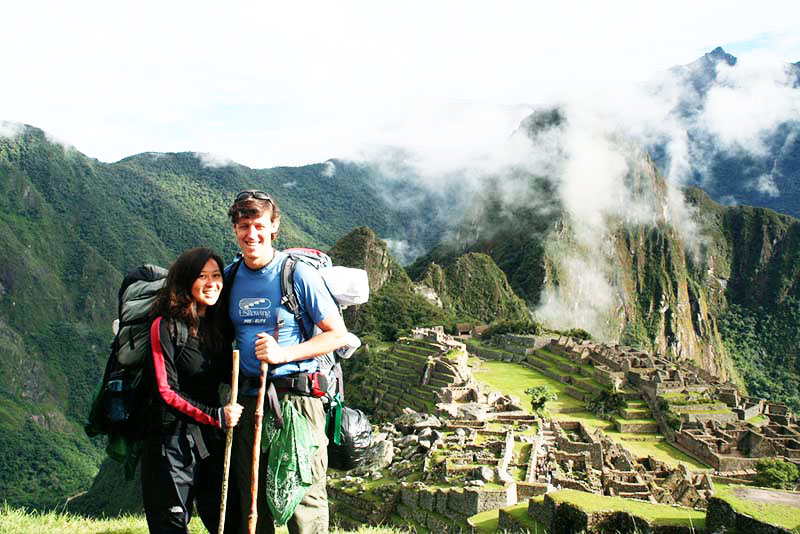
Machu Picchu, the end of this amazing hiking trail
The hiking trail Cusco – Choquequirao – Machu Picchu
- The hiking route from the city of Cusco to Choquequirao and from this point to Machu Picchu is the most complete and challenging one that exists in the ancient ‘Capital of the Incas’.
- Travel through ancient Inca roads surrounded by the most picturesque landscapes. On average it travels 115 kilometers in 8 days and 7 nights of intense trekking.
- The main points are Choquequirao and Machu Picchu. You reach heights of up to 5,085 meters above sea level (masl) to sites of only 2,000 masl
Below is a summary of this hiking route little known to tourists.
Day 1: Cusco – Cachora – Rosalina Beach
- The adventure begins with a trip by bus (3 hours) from the city of Cusco to the town of Cachora in the department of Abancay.
- After lunch, you will go on a 4 or 5 hour walk to the so-called ‘Playa Rosalina’ where you camp and have dinner.
Day 2: Rosalina Beach – Marampata – Choquequirao
- Very early, you leave on foot towards the hamlet of Marampata (4 or 5 hours) where you have lunch.
- Then you continue with a short route (1 hour and 30 minutes) you reach the archaeological site of Choquequirao.
- That afternoon is destined to tour the Inca constructions on this site.
Day 3: Choquequirao – Río Blanco – Maizal
- The day begins with a demanding climb to the Río Blanco sector (approximately 3 hours) where there is a lunch break.
- Then the walk continues to the area of Maizal, where camping and dinner.
Day 4: Maizal – Victoria Mines – Yanama
- This day is not as arduous as the previous one. It ascends for 3 hours to the Abra de Yanama (also known as the ‘Abra Victoria’).
- Then the descent continues to the Victoria mines, where silver was extracted and which is currently abandoned.
- After lunch you descend to the Yanama camp where you spend the night.
Day 5: Yanama – Totora – Collpa
- The difficulty is less that day. It descends through some slopes where you can appreciate the abundant flora and fauna characteristic of the place.
- In the area called ‘Totora’ there is a lunch break.
- Then continue with the walk to the Collpa camp, where there are products offered by the population.
Day 6: Collpa – La Playa
- One of the most relaxing days. It goes up through an open and descends until you reach the camp ‘La Playa’, nominated for the waterfall that refreshes visitors.
- It goes through coffee plantations and banana plantations.
Day 7: La Playa – Hydroelectric – Aguas Calientes
- Very early you start by a regular walk to the Hydroelectric station very close to Machu Picchu (approximately 5 hours).
- After a lunch you will travel for 2 hours in parallel to the Vilcanota River until you arrive at the town of Aguas Calientes, at the foot of the Wonder of the World where you will spend the night.
Day 8: Aguas Calientes – Machu Picchu – Cusco
- The last day is destined to know the Inca Citadel of Machu Picchu. You have breakfast very early (on foot or by bus) to the entrance door of the Wonder of the World.
- After a guided tour of the archaeological site, the visitor will have free time to enjoy the site on their own.
- That day you return to the city of Cuzo on a train trip and then by bus.
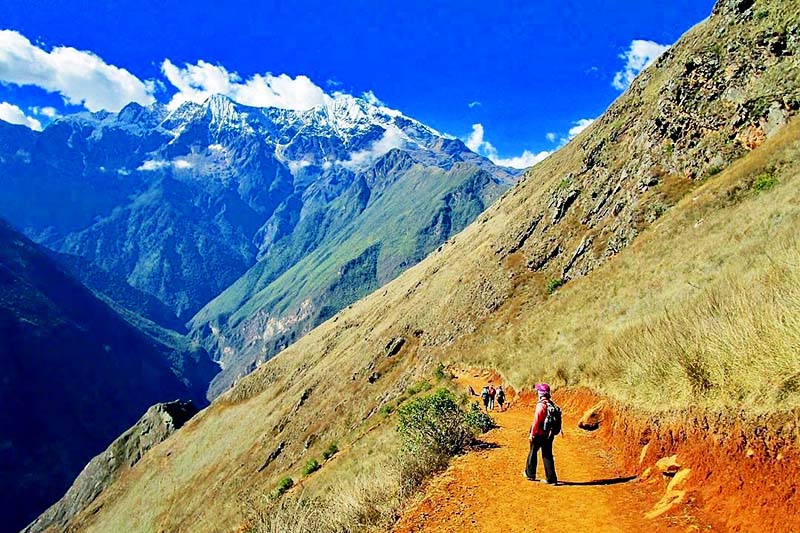
Incredible landscape on the trekking towards Choquequirao
The 8-day route that connects Choquequirao with Machu Picchu can be done with an organized tour or on your own. The safest option is to do it with a tour. If you go on your own do not forget to buy your tickets to Machu Picchu.
Other hiking routes to Choquequirao and Machu Picchu
These are some of the most famous hiking routes in Cusco:
- Salkantay trek – Five-day hiking route in its classic version where each tourist travels 70 kilometers on foot to reach Machu Picchu. On the route we also visit the Salkantay Pass, the Humantay Lagoon, as well as the Cocalmayo thermal baths.
- Inca Trail – Four-day hiking route in its classic version where each tourist travels on foot approximately 39 kilometers until arriving at Machu Picchu through the Intipunku or Puerta del Sol. It is famous for traveling the paths of the Incas, the so-called qhapac ñan.
- Inca Jungle – The Inca Jungle is a four-day hiking route in its classic version where adventure sports such as cycling, canoeing, zipline and trekking are practiced. On the route you can also enjoy the thermal baths of Cocalmayo. The last day we visit Machu Picchu through the town of Aguas Calientes.
- Lares trek – The Lares trek is a four-day hiking route in its classic version where approximately 37 kilometers are traveled until reaching Machu Picchu through the route through Aguas Calientes. It is known as the ‘cultural route’ to Machu Picchu as it includes visits to Andean towns with a lot of tradition.
- Huchuy Qosqo trek – The Huchuy Qosqo trek is a three-day hiking route in its classic version where you travel 13 kilometers through the landscapes of the Sacred Valley until arriving at Machu Picchu through the town of Aguas Calientes. It is an easy route and is recommended to visit with children and older adults.
Recommendations to visit Choquequirao and Machu Picchu
- The hiking route of Cusco – Choquequirao – Machu Picchu is one of the most extreme and adventurous experiences in Cusco.
- Tour the 2 most enigmatic sites that the Incas built over 600 years ago: Choquequirao and Machu Picchu.
Due to the physical effort required by the 8 days of trekking, it is necessary to take some precautions.
- Before starting the route it is important to have a previous acclimatization in the city of Cusco. Simply drinking plenty of water and accustoming the body to the height are enough to avoid probable discomfort.
- The walk is of medium-high difficulty. While you don’t need to be an expert mountaineer, it is important to be in a proper physical form to do so.
- The tours that offer this route generally include a specialized guide, food and camping. The visitor must provide sleeping bags, walking sticks and other accessories.
- Admissions to the archaeological sites of Choquequirao and Machu Picchu are also generally. It is recommended to look for an authorized travel agency.
Questions and answers about visiting Choquequirao and Machu Picchu
-
1) Is it dangerous to visit Choquequirao?
No, Choquequirao is an archaeological site that has many signs. Due to the difficulty of getting there (only with a hiking route), the Inca citadel is almost without visitors, available to tourists. It is a safe tourist attraction.
-
2) Is there a direct car to Choquequirao?
No, Choquequirao is located in an area that is difficult to access and can only be reached on foot after a walk of approximately 31 kilometers. Ground transportation can take you from Cusco to the community of Cachora, the starting point of the hike.
-
3) How many kilometers is the route from Choquequirao to Machu Picchu?
The hiking route from Choquequirao to Machu Picchu is 115 kilometers that are done in 8 days on foot and 7 nights in camping and tourist hotels.
-
4) How high is Choquequirao and how high is Machu Picchu?
The Inca citadel of Choquequirao is 3,033 meters above sea level; while the Inca citadel of Machu Picchu is at 2,430 meters above sea level.
-
5) Is there a cable car to get to Choquequirao?
No, there is currently a project to build a cable car that can take tourists to the Inca city of Choquequirao in a few minutes. The project is still in progress, but is expected to become a reality in a few years.
-
6) Which is cheaper to visit Choquequirao or visit Machu Picchu?
Machu Picchu can be visited on your own at a low cost or with a luxurious all-inclusive tour. Choquequirao, on the other hand, can usually be visited on a 4-day hiking route. Therefore, the cost to travel to Choquequirao may be higher.
-
7) When is the best time to visit Choquequirao and Machu Picchu?
The dry season (April to October) is considered the best time of year to visit Choquequirao and Machu Picchu. This is due to the few rains that make walking easier. The rains are usually intense in January, February and March.
-
8) Which is bigger Choquequirao or Machu Picchu?
The archaeological site of Choquequirao covers an area of 18 square kilometers (and there are still areas to be unearthed) while the archaeological site of Machu Picchu covers an area of 5 square kilometers.
-
9) Is the route from Choquequirao to Machu Picchu dangerous?
The route from Choquequirao to Machu Picchu is exhausting since you walk around 115 kilometers. However, if done with a formal tourism agency, the route is safe.
-
10) Can I do the route from Choquequirao to Machu Picchu on my own without a tour?
Yes, you can do the route to Choquequirao and Machu Picchu on your own. However, you must bring the indicated implements such as: tent, sleeping bag, food, shelter and more. Therefore, the best option – and the safest – is to choose a formal and safe tourism agency.
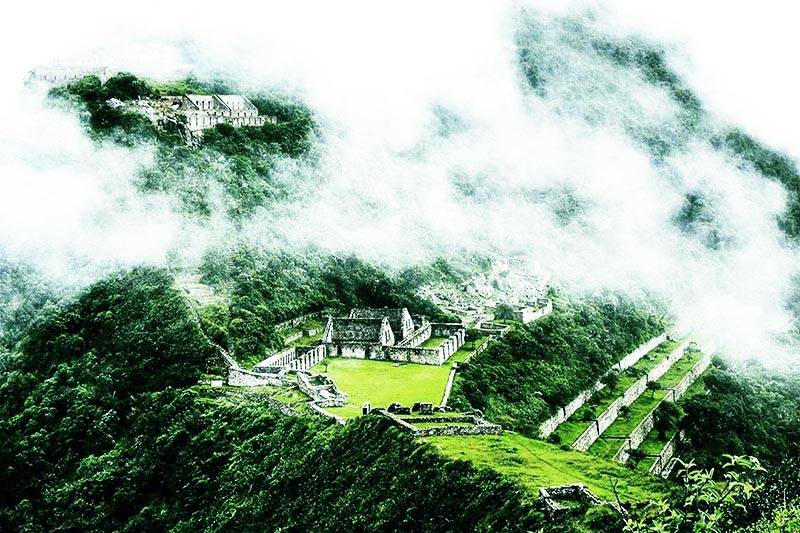
View of the ancient Inca city of Choquequirao
Advice from people who have been there
 By: Jennifer C.
By: Jennifer C.“The walk of life!“
“Choquequirao may be larger than Machu Picchu. The ruins are less explored and less restored. The beauty is in the walk and the visit to the ruins. I was there at one point completely alone, so there is no comparison with its more popular brother Machu Picchu (5 or 6 days hike from there)“
By Ticket Machu Picchu – Last updated, August 15, 2024
The post Trek Cusco – Choquequirao – Machu Picchu first appeared on Ticket Machu Picchu.
]]>The post Choquequirao, the other Machu Picchu: Frequently asked questions first appeared on Ticket Machu Picchu.
]]>Solve all your doubts about the archaeological site of Choquequirao.
- Choquequirao: definition
- Choquequirao: tour to the ‘Other Machu Picchu’
- Choquequirao Tour – Machu Picchu
- Choquequirao: Tips and more information
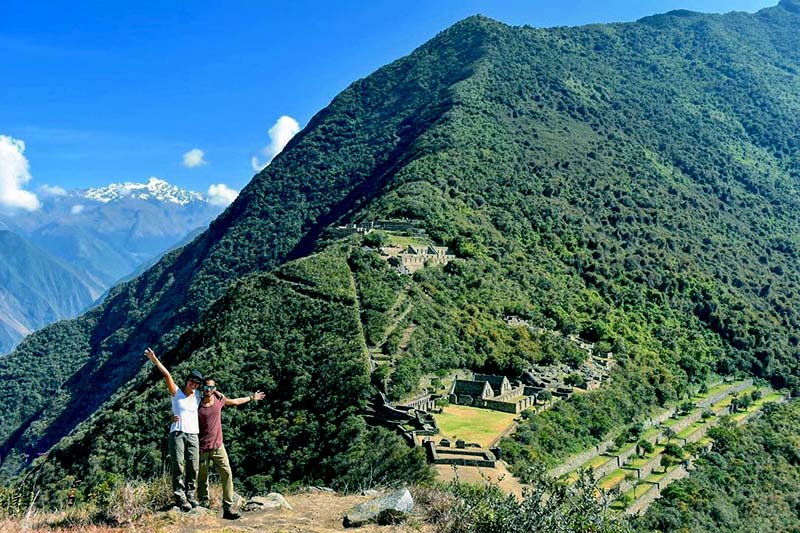
Tourists in Choquequirao
Choquequirao: definition
What is Choquequirao?
Choquequirao is an Inca archaeological site with characteristics similar to Machu Picchu. Its name means ‘Cradle of Gold’. Due to its similarity to the ‘Inca City’ it is known as the ‘Sacred Sister of Machu Picchu’.
Where is Choquequirao in Peru?
Choquequirao is in the Andes Mountains of Cusco, Peru. It belongs to the province of La Convención, in the district of Santa Teresa.
How to get to Choquequirao?
A Choquequirao is reached by Cusco or Abancay. The first destination is the town of Cachora. From there, one can walk up to Choquequirao. The walk is 1 day. The return is in the same way.
How high is Choquequirao?
Choquequirao is 3,033 meters above sea level (masl).
What to see in Choquequirao?
Choquequirao is home to impressive Inca constructions, such as: the Main Plaza, the Colcas, Inca Cemetery, the Kallankas, the Ushnu, platforms, etc.
Choquequirao continues in the process of excavation. It is estimated that to date, only 30% of the original Inca enclosure has been discovered.
Who built Choquequirao?
According to the investigations made in Choquequirao, it is estimated that the Inca site was built around 1536.
Due to its similarity with Machu Picchu, it is believed that the Inca Pachacutec founded the place. His son Tupac Inca Yupanqui was the one who had Choquequirao built.
What is the weather like in Choquequirao?
The archaeological site of Choquequirao has a temperate climate. The walk to this place has a hot climate due to the proximity of the so-called ‘Apurimac Canyon’.
Choquequirao: tour to the ‘Other Machu Picchu’
How to make the trek to Choquequirao?
The trek to Choquequirao can be done with an organized tour or on your own. In both cases, a walk from Cachora to the archaeological site is needed.
How to buy tickets to Choquequirao?
Tours to Choquequirao are purchased online or in the Historic Center of Cusco. If the tour is done on your own, you must purchase the entrance tickets when you arrive at the archaeological site.
How much does the Choquequirao tour cost?
The prices of the tours to Choquequirao vary according to the tourism agency and the number of people.
Prices vary from $ 500 to $ 350 per person.
What does a tour to Choquequirao include?
The Choquequirao tour includes the following:
- Camping equipment
- 2 days of feeding.
- Travel by bus from Cusco to Cachora.
- Entrance tickets to Choquequirao.
- Tourism guide service.
- Cargo service of luggage.
- Trekking poles (sticks).
How to go to Choquequirao without a guide?
To go to Choquequirao without a guide (on your own) you need to follow the indicated route and carry the necessary luggage (food and shelter). Once at the door of the archaeological site, only the entrance must be purchased.
The route to follow is the following:
- Cusco (or Abancay) – Cachora.
- Cachora – Marampata.
- Marampata – Choquequirao.
Choquequirao Tour – Machu Picchu
How is the Choquequirao – Machu Picchu tour?
The Choquequirao – Machu Picchu tour is one of the most extreme and memorable adventures in Peru. It is a walk that connects Cusco – Choquequirao and Machu Picchu in 8 days. The total route is 115 kilometers.
How much does the tour from Choquequirao to Machu Picchu cost?
The prices of the tours from Choquequirao to Machu Picchu (8 days) vary according to the tourism agency.
Costs vary between $ 1,300 to $ 1,000 per person.
Can I do the Choquequirao trek to Machu Picchu without a guide?
It is possible to make the route Cusco – Choquequirao – Machu Picchu by own. However, for this you need to have experience in trekking.
You must organize the appropriate luggage, acquire tickets in advance to Machu Picchu and follow the following route:
- Cusco – Cachora.
- Cachora – Marampata.
- Marampata – Choquequirao.
- Choquequirao – Abra Yanama.
- Abra Yanama – Collpa.
- Collpa – The Beach.
- The Beach – Hydroelectric.
- Hydroelectric – Aguas Calientes.
- Aguas Calientes – Machu Picchu.
Choquequirao: Tips and more information
How to go cheap to Choquequirao?
To visit Choquequirao economically, it is necessary to do the walk on your own. The necessary costs are:
- Entrance to Choquequirao.
- Transportation from Cusco to Cachora (and vice versa).
- Food for 2 days.
- Tents and sleeping bags.
- Mules or pack horses (optional).
When is the best time to go to Choquequirao?
The best time to visit Choquequirao is during the high season of tourism (from April to October). During those days, there is little possibility of rain, so the walks are safer.
How to hire muleteer and horse for Choquequirao?
The most comfortable way to ascend to Choquequirao is hiring muleteer and horse to carry luggage. The inhabitants of the town of Cachora offer this service before starting the walk.
Is Choquequirao dangerous?
Choquequirao is a difficult and demanding but not dangerous hike. The trails that lead to the archaeological site are well signposted. During the rainy season (from November to March), there may be landslides or flooding of the river so it is not advisable to do the trek at that time of the year.
What to take to Choquequirao?
During the walk to Choquequirao it is advisable to bring the following:
- A cap or hat.
- Comfortable and light clothing.
- Sunscreen.
- Hiking shoes.
- Trekking poles
- Repellent for mosquitoes.
- Water or rehydration.
- Poncho in case of rains.
- Sunglasses.
- Snacks
By Ticket Machu Picchu – Last updated, August 15, 2024
The post Choquequirao, the other Machu Picchu: Frequently asked questions first appeared on Ticket Machu Picchu.
]]>The post Choquequirao: trekking to the lesser known Inca lost city in Peru first appeared on Ticket Machu Picchu.
]]>- What is the Inca city of Choquequirao?
- What was the importance of Choquequirao?
- Is Choquequirao the last Inca refuge?
- Where is Choquequirao in Peru?
- How high is Choquequirao?
- When to visit Choquequirao?
- How to visit Choquequirao?
- How is the walk to Choquequirao?
- How is the walk from Choquequirao to Machu Picchu?
- Choquequirao without a guide
- What is the weather like in Choquequirao?
- Map from Choquequirao to Machu Picchu
- Recommendations for the trek to Choquequirao

Choquequirao
What is the Inca city of Choquequirao?
Choquequirao was an ancient Inca urban center. The American explorer Hiram Bingham knew the site in 1909 (before arriving at Machu Picchu). However, the excavations are slow and continue to date.
Inevitably Choquequirao was called the ‘Sister of Machu Picchu. But, while the Wonder of the World receives around 5 thousand visitors a day, ‘Choque’ is almost completely deserted.
What was the importance of Choquequirao?
As Machu Picchu, his famous sister, Choquequirao seems to have been a kind of royal city for the Inca nobility. It was built one or two generations before the arrival of the Spaniards.
It has several buildings such as the ‘Kallanka’: two ceremonial rooms with stairs and irrigation channels inside. It is one of the most important constructions.
Is Choquequirao the last Inca refuge?
It is possible that Choquequirao was the last refuge of the Incas when the Spanish invasion occurred. Due to its location, in an isolated place, it is thought that the Incas retreated during the Spanish ascent.
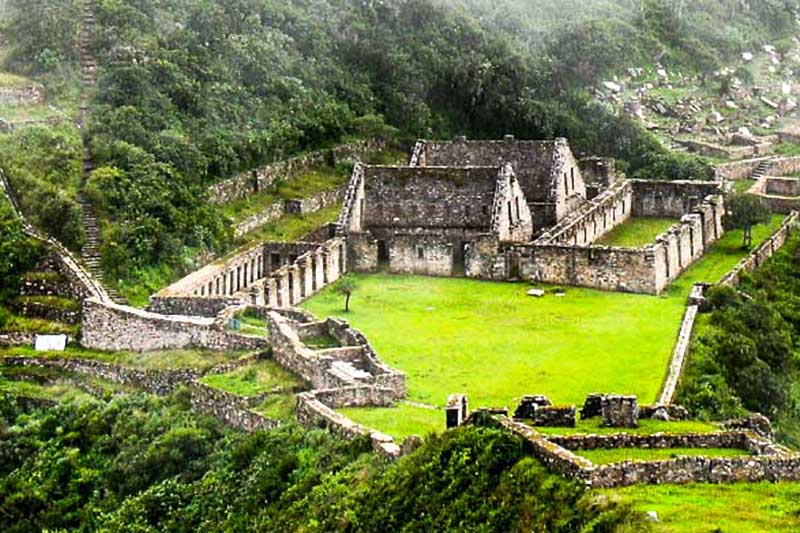
Main square of Choquequirao
Where is Choquequirao in Peru?
Choquequirao (Cradle of Gold in Quechua) is an Inca archaeological site located in the most remote of the Andes of Cusco, Peru.
The ‘Sister of Machu Picchu’ is in the Vilcanota mountain range, in the Salkantay massif. Due to its difficult location, currently, it is only possible to arrive with a hiking route.
Choquequirao is a trip to a place with few people that does not end up being unearthed.
How high is Choquequirao?
Choquequirao is located 3,050 meters above sea level.
When to visit Choquequirao?
The dry season (between April and October) is the best time to go to Choquequirao. Sweat, campsites and an incredible 4 day hike (2 outbound and 2 back) separate this ancient Inca city from any nearby road or hot shower. During those days, the route is easier due to the infrequent rainfall.
How to visit Choquequirao?
To get to Choquequirao you must hire a tour service. This can be obtained through a tourism agency in the Tourist Center of Cusco or via internet.
How is the walk to Choquequirao?
Way to Choquequirao:
- To visit Choquequirao you will first have to reach the town of Cachora (almost 4 hours by road).
- Then you will have to walk down to the Apurímac valley, closer and closer to the river bed of the same name.
- That night (the first) will camp in a place known as the Rosalina beach.
- The next day you must cross a river to begin the ascent to Choquequirao.
- That day you reach the remote village of Marampata. This small settlement serves as a gateway to ‘Choque’.
Once in Choquequirao:
- After sunrise in Marampata, you will arrive to the Inca city of Choquequirao.
- When I got there you will see that this city is huge. It extends over three hills and has 12 sectors (some still to be excavated).
Choquequirao is less photogenic than Machu Picchu but not less important. It offers a level of loneliness unimaginable in ‘other wonders’.
Way back to Cusco
- The return path is less arduous than the outward journey. It lasts only 1 day. The first section is on foot from Choquequirao to Cachora. The last one is by car to Cusco.
- Some tours offer to continue the trip from Choquequirao to Machu Picchu. This epic journey of 9 days is known as the ‘Trail of the Incas’.
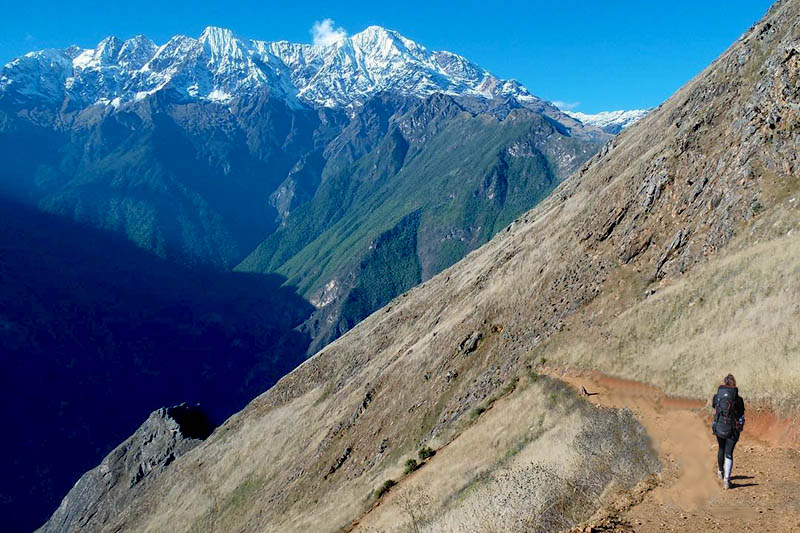
Walk to Choquequirao
How is the walk from Choquequirao to Machu Picchu?
- The Cusco – Choquequirao – Machu Picchu trekking route is one of the most incredible treks in Peru.
- The tours can last 8 or 9 days. On day 2, Choquequirao is visited, while on the 8th, Machu Picchu is visited.
- This route has a medium-high difficulty.
- The first section is a bus trip to the town of Cachora. The final return is with a trip by train and bus to Cusco.
- Tours include tourist guide service, transportation, food, entrance to archaeological sites and camping implements.
Choquequirao without a guide
Unlike the Inca Trail to Machu Picchu, the walk to Choquequirao does not need permits or tickets. This adventure can be done on your own.
- The first thing is to reach the town of Cachora. It can be reached from the city of Cusco or Abancay with public transport.
- It is important to calculate the weight of the luggage with the amount of food until arriving at Choquequirao. Only the necessary must be carried.
- Once in Choquequirao, you must pay the entrance to the archaeological site.
- The entrance includes a camping where to spend the night. The ticket allows to be 1 whole day in Choquequirao.
What is the weather like in Choquequirao?
Choquequirao has a temperate climate. The average temperature is 14ºC. During the dry season (from April to October) the heat reaches 25ºC. At night, the cold reaches 4ºC. In the rainy season (from November to March) fluvial precipitations happen more frequently.
Map from Choquequirao to Machu Picchu
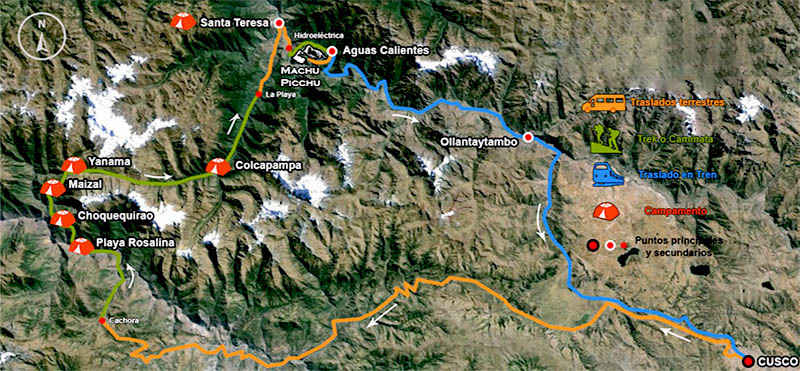
Choquequirao – Machu Picchu road map
Recommendations for the trek to Choquequirao
In Choquequirao, the construction of a cable car 5 kilometers high and 1.5 meters high is being prepared. The cable car can transport 3 thousand people each day.
By Ticket Machu Picchu – Last updated, August 15, 2024
The post Choquequirao: trekking to the lesser known Inca lost city in Peru first appeared on Ticket Machu Picchu.
]]>The post Choquequirao, the other Machu Picchu: location, height and more information first appeared on Ticket Machu Picchu.
]]>- Choquequirao, basic information
- Trekking route to Choquequirao
- More information about Choquequirao
- What are the differences between Choquequirao and Machu Picchu?
- Who discovered Choquequirao?
- How much does the entrance to Choquequirao cost?
- How much does a tour to Choquequirao cost?
- What is the admission schedule?
- What is the difficulty of the Choquequirao tour?
- What does a tour to Choquequirao include?
- Photo gallery Choquequirao
- Questions and answers about the trip to Choquequirao
Choquequirao, basic information
What does Choquequirao mean?
Choquequirao is a Quechua word that means ‘Cradle of Gold’. The name comes from the nomination of a hill near the archaeological site.
Where it is located?
Choquequirao is located in one of the fringes of the mountain Salkantay, north of the Apurímac River. It is currently located in the district of Santa Teresa, province of La Convención, department of Cusco, Peru.
How high is it?
Choquequirao is located 3,033 meters above sea level. Due to its location, it is presumed that this Inca enclosure served as a checkpoint between the main Inca sites such as Pisac, Cusco and Machu Picchu.
What’s in Choquequirao?
Choquequirao has only been excavated 30%. In spite of this, it already has several very important Inca constructions:
- Main square – The main plaza or Huaqaypata divided the site into two. It is a two-story stone construction. Next to it, there are other buildings connected to each other.
- Colcas – Typical constructions of the main Inca centers. In Choquequirao, these platforms have internal subdivisions. The purpose of these deposits was to store products for food, clothing and others.
- Platforms – Choquequirao has an important number of platforms for cultivation. In the western sector there are 22 engravings in the shape of a flame arranged on 15 platforms. These figures are known as the ‘Llamas del Sol’.
- Housing – In the highest part of Choquequirao, there are up to 5 buildings whose purpose was probably housing for the priests of the enclosure. It is believed that this Inca site was an important ceremonial center.
- Inca Cemetery – Also known as the ‘Triumphal Wall’. There were found 17 funerary bales and a water gutter called “The house of the fall of water”.
- Kallankas – These rectangular buildings had multiple functions such as workshop, administrative center, meeting space, etc. In Choquequirao there are 2 Kallankas in whose walls there were gutters that supplied water.
- Ushnu – This oval platform construction is located on the top of a hill. Due to the wall that surrounds it and of the privileged view to the snowed ones, the river and all the enclosure; it is believed that it had a religious purpose.
How to get to Choquequirao?
The only way to get to Choquequirao is by land. Currently, the main route is going to the town of Cachora (2,903 masl), 3 or 4 hours by road from the city of Cusco (2 hours from the city of Abancay).
There, start the hike to the Inca archaeological site. The route crosses important points such as Capuliyoc, Maranpata and Sunchupata. It is estimated that from Cachora, after 32 kilometers on foot you will reach Choquequirao.
The walking time from Cachora to Choquequirao on average is 10 to 12 hours. A cable car is currently being built which would significantly reduce this time. This project could exponentially increase the visit to this archaeological site. It is expected that with the cable car the trip to Choquequirao will take only 15 minutes and will have the capacity to carry up to 400 people per hour.
Map Tour 4 days to Choquequirao
How’s the weather?
The archaeological site of Choquequirao is located at 3,033 meters above sea level. The climate is temperate with cold at night. However, the tourist will not remain in the Inca site until after sundown.
However, the road that leads to the summit of Choquequirao is hot due to the proximity of the Apurímac canyon. It is estimated that the temperature at the archaeological site varies between 5º C and 25º C.
How is the flora and fauna in Choquequirao?
Choquequirao is home to a variety of animals and birds such as the condor, foxes, vizcachas, pumas, hummingbirds, spectacled bears and the cock of the rocks In addition, like Machu Picchu, there is a great variety of orchids.
Trekking route to Choquequirao
4 day tour to Choquequirao
The most usual way to get to Choquequirao is through the trekking route of 4 days and 3 nights. You can hire this tour online or directly in an agency in the city of Cusco.
The tour to Choquequirao in 4 days and 3 nights is like this:
- Day 1: The tour begins in the city of Cusco between 5 a.m. or 6 a.m. At that time, the bus leaves for Cachora (4 or 5 hours). There you rest a little to start the trekking route. After about 5 hours of walking, you spend the night on the banks of the Apurímac River.
- Day 2: The walk continues very early after breakfast. The ascent becomes more arduous until reaching Marampata (3,000 masl). The route continues until finally arriving at the archaeological site of Choquequirao, after 10 kilometers of road.
- Day 3: After appreciating the most remote spaces of Choquequirao, the way back begins by the same way in which it was arrived. After almost 5 hours of roads, a camp is set up in the Chiquisca area.
- Day 4: The last day starts early. On the route you will reach Wayna Qali viewpoint where you will appreciate the beauty of the Apurímac canyon (considered the most beautiful in South America). After approximately 3 hours of walking, you will reach the town of Cachora where a car will return the tourist to the city of Cusco.
Tour Cusco – Choquequirao – Machu Picchu
There is another tour that connects Choquequirao with Machu Picchu in 8 days and 7 nights. In total 115 kilometers of history and adventure are covered.
- Day 1: The adventure that day begins in Cusco and ends on the banks of the Apurimac River after a bus trip to the town of Cachora. You walk between 4 or 5 hours that day.
- Day 2: The day starts early with an uphill and difficult road (4 or 5 hours) until arriving at the archeological site of Choquequirao ..
- Day 3: After touring Choquequirao, the route continues through places such as the Río Blanco sector and the Maizal sector. The day is demanding but rewarding for the landscapes it crosses.
- Day 4: The day crosses the Yanama pass, to then reach the so-called ‘Mina Victoria’, an ancient silver deposit. The day is not as demanding as the previous one.
- Day 5: That day begins to descend to the tropical geography of Peru. The zone of ‘Totora’ and the camp of ‘Collpa’ can be seen. The day is not of high demand.
- Day 6: The day goes through beautiful landscapes like different banana plantations and coffee plantations. The descent arrives at ‘La Playa’, where a waterfall falls.
- Day 7: The day starts very early until you reach the so-called ‘Hydroelectric Station’. The walk continues to the town of Aguas Calientes, at the foot of Machu Picchu. There he stays overnight in a hotel or lodging.
- Day 8: The day begins with an ascent to Machu Picchu. That morning, and part of the afternoon, is dedicated to tour the Wonder of the World. Then, the return to Cusco is by train and bus.
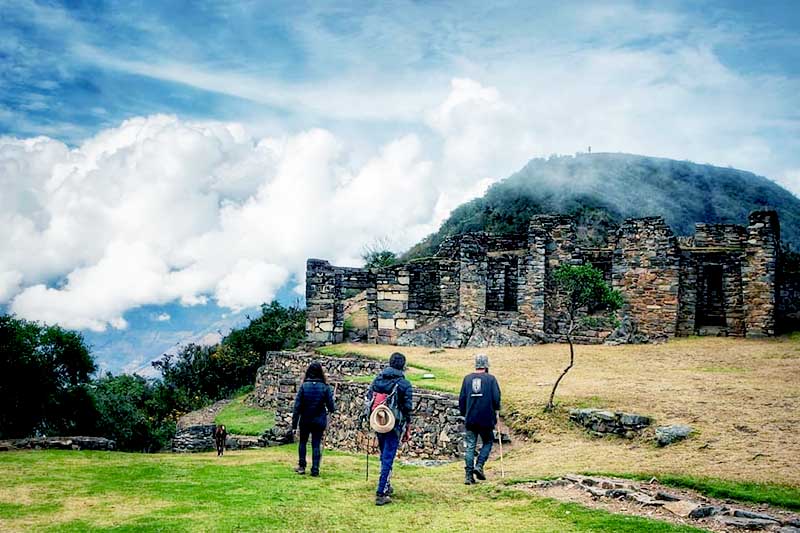
Tourists touring Choquequirao
Choquequirao on its own and without a tour?
Although many tourists choose to arrive in Choquequirao with a tour, it is also possible to do it on their own. To achieve this, you must follow the usual route and pay the entrance fee at the entrance to Choquequirao.
Important information to get to Choquequirao on your own:
- You can start the trip by bus to the town of Cachora from the city of Cusco or Abancay. You can use public transportation services at low cost from both cities.
- From the village of Cachora, the trekking route begins through well-marked paths.
- When walking on your own it is important to calculate the weight of the backpack. The food should last at least 5 days but should not weigh more than necessary.
- The normal tour lasts 4 days and 3 nights. By doing it on your own, the visitor can take more or less time.
- Once in Choquequirao, you must pay the entrance price (tours include the entrance). With that ticket, the visitor can spend the night in the surrounding camps to the Inca archaeological site.
What to take on a trip to Choquequirao?
Whether with a tour or on your own, there are some things necessary for all tourists visiting Choquequirao:
- Sunscreen.
- Repellent against mosquitoes.
- Hat or cap.
- Sunglasses.
- Sticks for walking.
- Raincoat (in case of rainfall).
- Sleeping bags (not included in the tours).
- Trekking shoes
- Trekking backpack.
- Food.
When is the best time to travel to Choquequirao?
The best time to travel is between April to October. Choquequirao has two stations:
- Rainy season (from November to March): it is characterized by frequent fluvial rainfall. The sun is not so intense but the rain can harm the walk.
- Dry season (from April to October): it is characterized by the lower frequency of rains. The days are hotter and the nights are colder. However, the low possibility of rain, favors the walk.
Tips to go to Choquequirao
- While you do not need to be an expert mountaineer to visit Choquequirao, it is recommended that you do a little exercise before the adventure.
- Due to the altitude at which Choquequirao is located, altitude sickness or soroche can cause discomfort during the ascent. It is advisable to acclimatize to the climate of Cusco (or Abancay) before starting the trekking.
- Unlike Machu Picchu, Choquequirao receives very few visitors per day.. It is recommended to enjoy the nature and the archaeological site but with responsibility.
More information about Choquequirao
What are the differences between Choquequirao and Machu Picchu?
| Choquequirao and Machu Picchu differences | ||
| Data | Choquequirao | Machu Picchu |
| Translated names | ‘Golden cradle’ | ‘Old mountain’ |
| Location | Convención Province – Santa Teresa, Cusco | Urubamba Province – Aguas Calientes, Cusco. |
| Altitude | 3,033 masl. | 2,430 masl. |
| Extension | 18 square kilometers | 120 square kilometers |
| Function | Citadel and religious center | Citadel and religious center |
| Building date | 1536 AD | 1450 AD |
| Discovery date | 1909 (Hiram Bingham) | 1911 (Hiram Bingham) |
| Entrance ticket | 60 S/. (general admission) | 152 S/. (Machu Picchu ticket only) |
| How to get? | With a 4-day walking route (round trip) | With a 4-hour tourist train ride (optional 4-day Inca Trail) |
| weather | Temperate (from 5º C to 25º C.). | Warm temperate (from 13ºC. to 26ºC.). |
| Tour price | USD 510 for a 4-day tour (approximately) | USD 250 for a 1-day tour (approximately) |
Who discovered Choquequirao?
As well as Machu Picchu, many people knew the existence of Inca archaeological remains in Choquequirao. However, it was Hiram Bingham (the discoverer of Machu Picchu) who in 1909 made known to the world the importance of the Inca site..
It was not until 1970 that excavation work began. Currently, it is estimated that only 30% of Choquequirao is unearthed and put on display to the public.
How much does the entrance to Choquequirao cost?
If you travel by your own account you will have to pay the following rate at the entrance to Choquequirao:
| How much does the entrance to Choquequirao cost? | ||
| Rate for all countries | Price in soles (S/.) | Price in dollars (U$D) |
| General adult | 60 S/. | 18 U$D |
| College student | 30 S/. | 9 U$D |
| Childrens | 25 S/. | 7 U$D |
*The price of the ticket allows you to stay more than one day in Choquequirao.
How much does a tour to Choquequirao cost?
The price of a 4-day, 3-night tour to Choquequirao depends on the number of visitors in a group.
Cost of a tour to Choquequirao on average:
| How much does a tour to Choquequirao cost? | ||
| Number of visitors | Price in soles (S/.) | Price in dollars (U$D) |
| 2 people | 1632 S/. | 510 U$D |
| 3 people | 1408 S/. | 440 U$D |
| 4 people | 1280 S/. | 400 U$D |
| 5 people | 1120 S/. | 350 U$D |
What is the admission schedule?
Choquequirao opens its doors every day from 7 am to 5 pm The ticket allows you to spend the night in a camp located near the Inca site.
What is the difficulty of the Choquequirao tour?
The trekking route to Choquequirao has a medium-high difficulty. From the town of Cachora to the archaeological site, a total of 31 kilometers are traveled, and another 31 kilometers. The hike includes a descent and a steep climb.
What does a tour to Choquequirao include?
The tour to Choquequirao depends on each tourism agency. In general, these include:
- Transportation from Cusco to the town of Cachora.
- Food (breakfast, lunch and dinner for the duration of the trek).
- Camping equipment
- Carriage of luggage.
- Tickets to Choquequirao.
- Official tourist guide.
- Transportation from Cachora to Cusco.
Choquequirao receives an average of 20 tourists per day (Machu Picchu receives 5,000). With the construction of the new cable car, this number will increase to 3 million per year. However, for tourists who visited Choquequirao it is a special experience to tour the archaeological site with hardly anyone there. Even the second night camps next to the Inca citadel.
Questions and answers about the trip to Choquequirao
-
1) How can I get to Choquequirao?
The route to Choquequirao is done on foot starting from the town of Cachora (165 kilometers from the city of Cusco). The walk is demanding. You travel 32 kilometers until you reach Choquequirao. The return leg is the same.
-
2) Where are the ruins of Choquequirao?
The archaeological site of Choquequirao is located on the slopes that make up the Vilcabamba mountain range. It belongs to the district of Santa Teresa, province of La Convencion in Cusco. You get there with a walk of 32 kilometers.
-
3) What is the price of the entrance ticket to Choquequirao?
The entrance to Choquequirao costs 60 soles for foreign adults and 30 soles for university students.
-
4) What is the best time to go to Choquequirao?
According to the tour guides who carry out the route, from April to November, the walk to Choquequirao can be made with a clear sky, ideal for this adventure. In these months is the best time of year to visit Choquequirao.
-
5) How much does a tour to Choquequirao cost?
A tour to Choquequirao costs from 350 to 500 dollars per tourist or even more depending on the tourism agency of your choice. The tour lasts 4 days.
-
6) Can I go to Choquequirao without a guide?
Yes, the route from Cachora to Choquequirao is free for tourists and anyone can do it on their own. It is also recommended to hire the company of a tour guide.
-
7) Can I camp in Choquequirao?
Yes, the entrance ticket to Choquequirao allows camping next to the archaeological site (in an area designated for camping).
-
8) When is the worst time to visit Choquequirao?
In the rainy season, the walk to Choquequirao becomes more difficult due to the rains that can occur at any time of the day. The rainiest months are January, February and March.
-
9) Is the trip to Choquequirao dangerous?
The route to Choquequirao is safe. However, due to the difficulty of its paths, it is recommended to be in good physical condition. This way you can make a much safer walk.
-
10) What clothes to wear on the trip to Choquequirao?
For the route to Choquequirao, do not forget to bring light clothing, comfortable and resistant shoes, a windbreaker jacket, sunscreen, mosquito repellent, a comfortable backpack, a poncho in case of rain, snacks, rehydrating drinks, documents and cash.
Advice from people who have been there
 By: De: Mariana L.
By: De: Mariana L. “Choquequirao incredible “
“I came with my husband and it was really the best to see llama figures on the platforms... really a unique place“
By Ticket Machu Picchu – Last updated, August 15, 2024
The post Choquequirao, the other Machu Picchu: location, height and more information first appeared on Ticket Machu Picchu.
]]>The post The adventure to the ancient Inca city of Choquequirao first appeared on Ticket Machu Picchu.
]]>It is possible that when you are more than halfway to the Inca city of Choquequirao, thoughts of a beach, your feet in the sand, palm trees and an ice-cold juice will slip into your mind, and you will wonder what you are doing there, heading to a city of stone, doing the opposite of a vacation, which is the equivalent of physical rest? Then you will see mosquitoes that will bring you out of your thoughts. You will see people dressed in traditional costumes, working crops of all colors, donkeys and other farm animals, including llamas, grazing. A muleteer on horseback moving at the speed of Neymar may make you a little envious.
- Choquequirao, a great adventure
- Advantages of going to the Choquequirao ruins at this time
- The Choquequirao story
- On the way to Choquequirao
- Back home

Tourist with the background of Choquequirao
You may feel short of breath at times, but it’s not just the altitude. The cornices, the jungle, the light that slips through the trees, the rainbows and the noises in the undergrowth, as if someone were accompanying you, but without wanting to be seen. When you hear this, be certain that you are hiking to a remote place between the mountain range and the jungle, the ancient city of Choquequirao.
Choquequirao, a great adventure
When you start the journey to Choquequirao from the edge of a hill, you will have to cross three mountains, cross the Apurimac River and then go up and down a path that winds through clouds that often touch each other to rain; when you have land on your face, you will feel that nature owns you. Something you should know, is that not for everyone, it is not Machu Picchu and its possibilities to get there, by train, on foot or by bus, and that it is not something whose planning you should take lightly. It is an Inca experience of deep meaning, capable of expanding the consciousness, directly related to the desire to arrive, the uncertainty of what is missing and the conviction, apparently innate in people who decide to take the walk to reach Choquequirao, even if you have to sweat for every toe or ask forgiveness to the Pachamama.
Every effort has a reward and in this case: it is an ancient city with stone structures five centuries old, 3,100 meters above sea level; terraces that in the past were the main cultivation lands to maintain the city, scattered along the steep slopes of mountains guarded by condors, temples, walls decorated with figures of llamas and alpacas, community houses; a whole museum of sculptures of the past, preserved at the level of the sky.
Advantages of going to the Choquequirao ruins at this time
- Far away from everything: that is another fundamental value, another reason why it makes sense to walk 53 kilometers, during 5 days, to those constructions in the middle of the jungle. The Inca city of Choquequirao is still a place to be discovered.
- There is no one on the trail: or at most, a few other trekking enthusiasts – mostly young Europeans – the people you will meet along the way, at small rest stations and campsites in between.
- You can tour the city alone: not to detract from the beauty of the wonder, but yes, Machu Picchu is visited by thousands of people every day. In Choquequirao you will not see more than 30 adventurous people.
In a present of incredible destinations promoted even in little boxes of phosphorus, it is difficult to enter and visit a historical monument of the magnitude of Choquequirao practically alone. This is another aspect that justifies with creses the sacrifice of walking to this city. In addition, for now, you do not have to book your entrance tickets so far in advance, as in the case of Machu Picchu tickets to enter the Huayna Picchu mountain, or the entrance tickets to walk the Inca Trail to the Sun Gate. In addition, in Choquequirao and other historical sites in the middle of mountains, the journey ends when you return to the starting point. So you have nothing left to do but retrace every step you have taken.
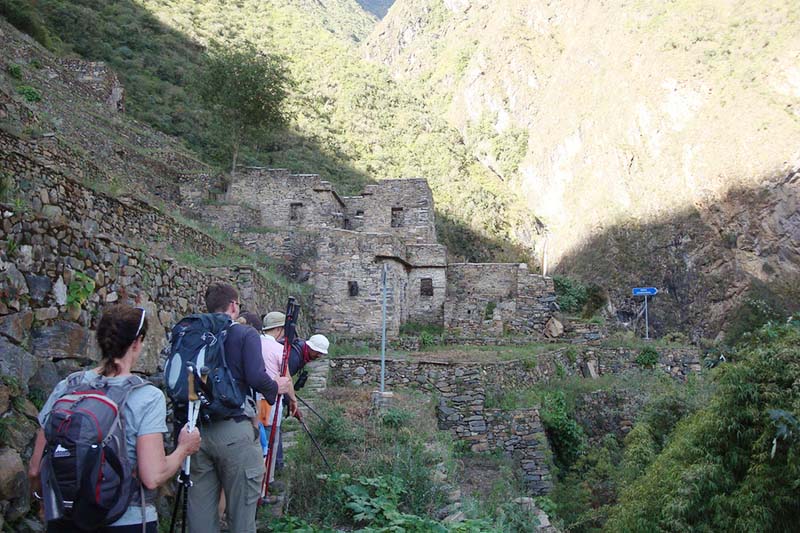
Walking through the constructions of Choquequirao
The Choquequirao story
If you believe that Choquequirao was discovered by a North American foreigner with a khaki hat, who asked some of the descendants of nearby families if they had heard of an ancient Inca city in the middle of the jungle, just like Machu Picchu; well, you are right, indeed, it is the same North American with a khaki hat. This foreigner hired a local shepherd as a guide, paid him for some donkeys and they started walking. Choquequirao means “cradle of gold” and was discovered by Hiram Bingham in 1909. However, while Machu Picchu achieved full glory. What is considered its sacred sister (Choquequirao) was covered by the dense jungle for much longer. And it was not until 1986, that the Peruvian government began the restoration work that made it possible, just some time ago, that people can reach the Inca city of Choquequirao, following in the footsteps of Bingham.
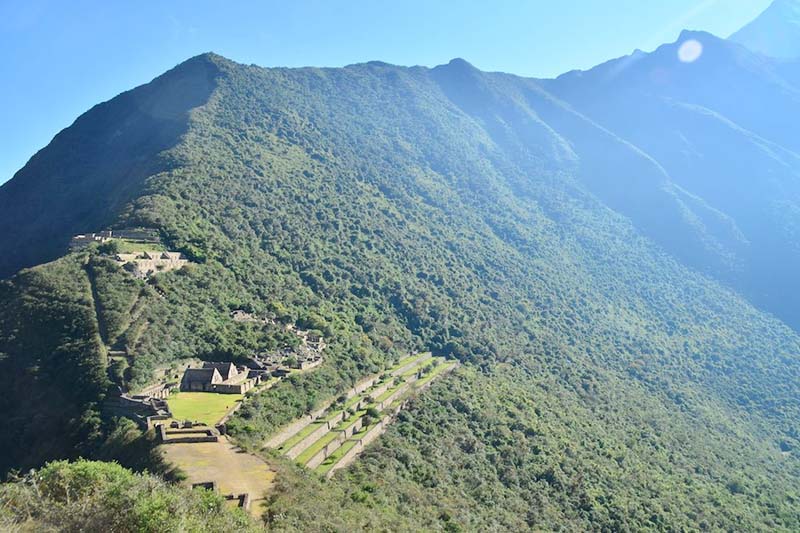
View of the central plaza of the Inca city of Choquequirao
On the way to Choquequirao
The journey begins at the Cusco airport, after a stopover in Lima. It is the starting point and the place where you will begin to feel the physiological effects of exposure to altitude, the 3,400 meters of the city of Cusco, can make people from any coastal city, feel discomfort, take it as a symbolic price you pay for entering the atmosphere of religious and cultural syncretism of the ancient capital of the empire of the Incas. There are several ways to avoid the symptoms of altitude sickness, you can start by resisting the temptation of that pagan god called pisco sour.
You will board a van through winding roads and leave behind all traces of connection with everyday life, this vehicle will leave you in the village Cachora, from that moment you must walk, you can not stop or you risk staying in the middle of nowhere. And the classic trekking situations will begin; right where the car road ends, inside the post that works as a shelter and where you can stock up and have a hot drink before leaving. The place is called Abra Capuliyoc (at 2,850 meters above sea level). There is a small wooden table (somewhat puny), a map, mosquitoes, backpacks. You will be surrounded by the immensity of the mountains, white landscapes covered with snow, and a gorge that causes vertigo. Peru with open veins.
-
Your team
You will have a team of porters, a cook, a guide and beasts of burden with the camp in tow, the team arrives in advance to the camping sites, to wait for you with the camp set up and the food ready. A luxury if you take into account that you will walk between 8 and 10 hours per day. You will appreciate it.
-
First day of trekking to Choquequirao
On the first day you will have the challenge of a 1,600 meter descent over 15 km to the banks of the Apurimac River, it is key to use poles so as not to overload your legs; walk at your own pace and do not rush. A mountaineering maxim holds that “those who go slow, arrive safely”. Economizing your energy means that you will have some to enjoy the dinner and the chatting during it. After 8 hours of rest until about 4 a.m., you will have a quick breakfast, usually based on Andean cereals.
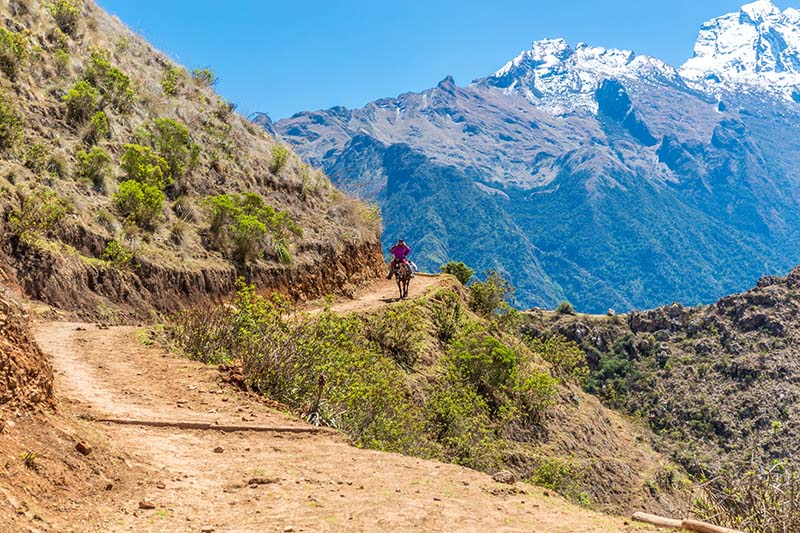
Road to Choquequirao
-
Second day of trekking to Choquequirao
The second day is a challenge for the body and mind, climbing 1,500 meters to reach 3,100 m.a.s.l. following a zigzag along the vertical slope of the mountain. It is not about climbing, but following a path with great care, it requires lungs, effort and concentration. There is only one thing that can improve the scenery and that is a little rain to bathe them under the intensity of the sun and of course one or two rainbows. You can also imagine the people who traveled that same path, carrying food, metals and other valuables between the main cities of the empire.
-
Arrival at the ruins
From Marampata at 2,910 m.a.s.l. there is almost nothing left before you reach the ruins. Here you will have two options: sleep in the camp and arrive at the ruins very early in the morning, or move on that same afternoon and return to the tent at night. It is an hour’s walk along a jungle trail, among ferns and orchids. Nearby there are gates, tiles and a direct corridor to an aqueduct; stairs from centuries ago, signs of the proximity of the city. Finally you will enter the city through an old priestly house and you will be stepping on the central platform of Choquequirao. Objective accomplished.
You will be able to wander, from a huge room of about 150 meters in diameter, through stairways and passageways that lead to other rooms, temples, residences, sacred places and others. This place could have been a religious altar. You will also be able to perceive the echo of his voice, and descend to the cultivation terraces, where 22 figures of llamas carved as cave paintings appear. You will be able to notice, at first sight, the mathematical logic that governs the constructions and the Inca pretension to dominate everything from above. It is possible that like the Inca city of Machu Picchu, this may have served as a link to unite the Andes of Cusco with the Amazon jungle.
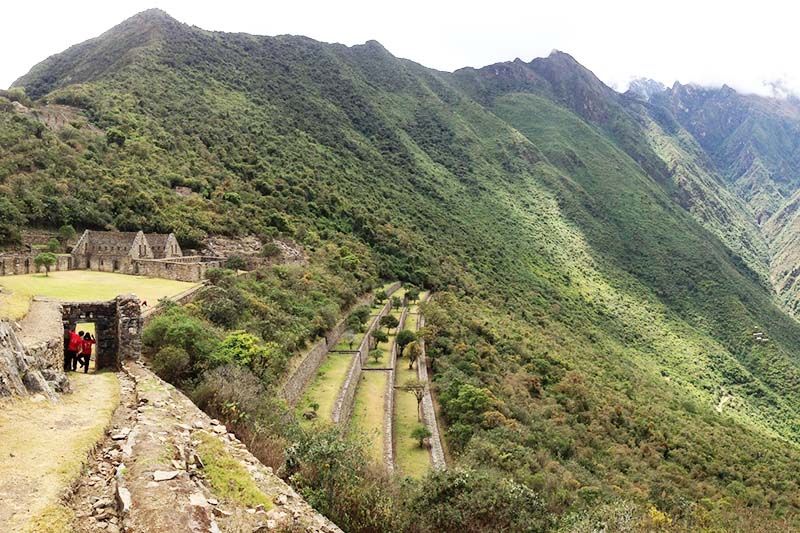
Entrance to the central plaza of Choquequirao
Back home
Two days later, on the way back you will wake up with the view of the Apurimac valley, in a place known as Cocamasana. You will start your last day of trekking at 4 am and will be at the Capuliyoc refuge at 8 am. The idea is to find yourself and feel alive (organic and functional). After finishing this hike, you will feel some happiness to be back to civilization, say goodbye to the porters, meet the driver, who days ago, left you at the beginning of the hike. We assure you that when you arrive in the city of Cusco, you will want to celebrate the journey with wine.
Whether you want to visit Choquequirao, Machu Picchu or any other city in the Sacred Valley of the Incas, contact us at [email protected], we will help you plan your trip.
Advice from people who have been there
 By: Jean F.
By: Jean F.“I prefer Choquequirao to Machu Picchu“
“I prefer to say that “I am one of the hundreds who have visited Choquequirao” than to say that I am one of the millions who have visited Machu Picchu. I had the opportunity to visit both Inca cities in the same trip and there is only one thing I can tell you. Machu Picchu is one of the best sightseeing you can have (maybe in the whole world), but Choquequirao is one of the best excursions you can have (maybe in the whole world).“
By Ticket Machu Picchu – Last updated, July 22, 2024
The post The adventure to the ancient Inca city of Choquequirao first appeared on Ticket Machu Picchu.
]]>